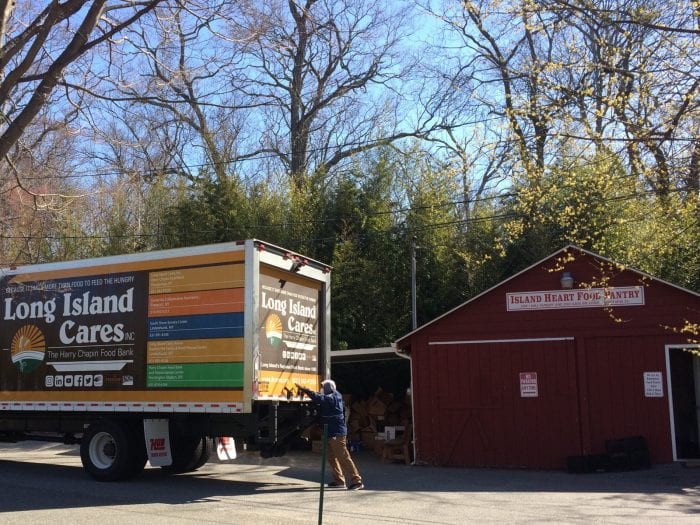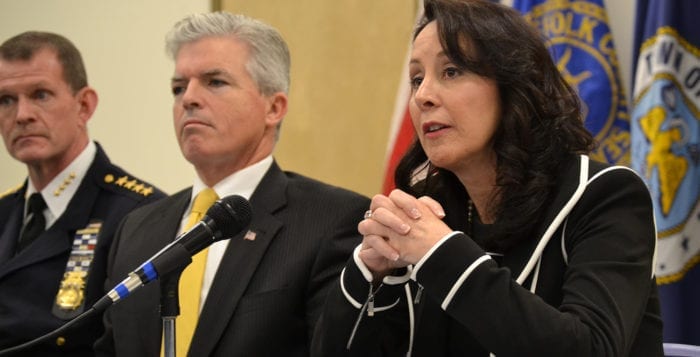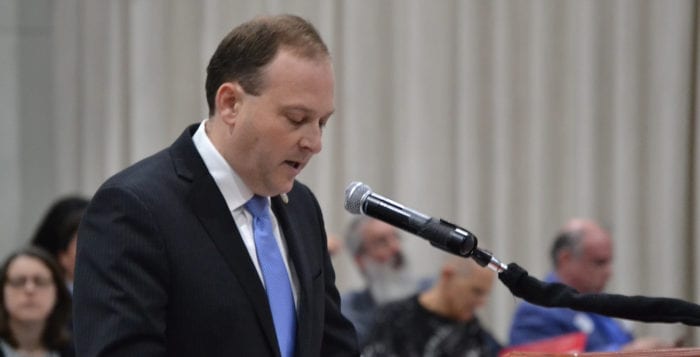This post has been updated April 8 to give information about the Island Heart Food Pantry
By Leah Chiappino
In the wake of COVID-19, local food banks and pantries are struggling to keep up with increased demands, and in some cases decreasing volunteers and inventory.
For instance, Hauppauge-based Long Island Cares, a food bank that operates six distribution centers and has several mobile distribution events, has seen the closure of 44 out of the 349 food pantries to which it distributes. While their donations are down 23 percent, LIC holds more than a million pounds of food in inventory, and anticipates receiving an additional 375,000 pounds from the U.S. Department of Agriculture.
Long Island Cares CEO, Paule Pachter, said the problem does not stem from lack of inventory, but public hysteria.
“With having to limit volunteers, it becomes hard for us to do mass distribution events when you have people in a panic yelling at our volunteers and staff demanding more food.”
— Paule Pachter
“People are starting to panic,” he said. “When you have people hoarding toilet paper, and coming to multiple distribution events, it becomes hard to handle. There are [some] 300 food pantries open that people can access. With having to limit volunteers, it becomes hard for us to do mass distribution events when you have people in a panic yelling at our volunteers and staff demanding more food.”
He added he is confident that school districts mostly have the resources to provide meals themselves, and only need limited help from outside sources. The food bank has responded to almost 650 COVID-19 related calls, and is operating a 24/7 hotline for those in need of assistance. LIC is continuing mobile distributions while practicing social distancing and leaving home delivery donations outside people’s doors.
Island Harvest Food Bank, also from Hauppauge, is seeing a dramatic influx of need, too, due to COVID-19, with donations down about 40 percent, according to Randi Shubin Dresner, the organization’s president and CEO.
The food bank started an emergency response plan about two weeks ago, while trying to still deliver food to local food pantries and community organizations. As more and more places closed, Dresner said the organization began to pursue other avenues to ensure those who are in need still have access to food.
“We have a long list of people waiting to get food from us,” Dresner said. “Every day there is hunger on Long Island, even in normal times. When you couple that with a pandemic, things become very difficult.”
Normally 90 percent of Island Harvest’s inventory is donated, but recently it had to make a $450,000 purchase of food supplies, an amount Dresner said is likely to double in the future. A large portion of the purchases are “family boxes” of food, enough to feed a family of four for four days. Others are individual meals and meals for seniors.
“There are tens of thousands of people that are homebound, and we can’t get to them all,” Dresner said. “We’re going to do as much as we can, and hopefully some of our partner organizations will be able to accomplish what we can’t. These are uncertain times and unchartered waters that we’re dealing with. People are scared, and we want to be responsive to as many people as we can, which is what we always do.”

The organization is working to deliver food to homebound seniors and veterans. It is also partnering with school districts such as William Floyd, Copiague, Brentwood and Wyandanch to help supplement the meals the districts are providing and ensure there is enough to bring home to entire families, not just children.
Dresner said Island Harvest is committed to keeping safe practices. Employees are rotating working from home and going into the office, and field and office workers are separated.
The organization also employs what it calls community resource navigators, to help people apply for food stamps or referrals to other services. Dietitians are on staff to help with nutrition needs.
Dresner said the food bank has not had a problem attracting volunteers, as people who have to stay at home want to find a way to help out.
The CEO added Island Harvest is accepting prepared and unprepared food from various restaurants, caterers and country clubs.
The organization prefers monetary donations over food donations, as the organization specifically can buy bulk food at a discounted price. Monetary donations can be made on the organization’s website at www.islandharvest.org/covid. Those in need should email [email protected] or call the headquarters at 516-294-8528.28
Some local food pantries seem to be operating at a reduced level. The Ecumenical Lay Council Pantry in Northport, whose staple is allowing people to come in and feel as though they are shopping, is still operating during normal hours but by a drive-through process.
The Island Heart Food Pantry, which is located in Middle Island and has operated out of the Mount Sinai Congregational Church for 40 years, has had to reduce its normal bevy of volunteers to just three a day on average, according to director Kathy Lahey. This is the new rule, mostly to maintain social distancing.
Meanwhile, because so many surrounding food pantries have closed, she said they have seen a doubling in the number of people who come to pick up food, especially seeing a large increase in the number of children looking for meals, now that many don’t have access to breakfast and lunch at school.
Before the pandemic, the organization operated as a “client choice” pantry, where people could walk in to choose which foods they got. Now everything is done with the clients inside their vehicles. Volunteers, bedecked in gloves and masks, go to each, in turn, to ask what their preference is, before giving it to them in bags and having them head out as soon as possible.
“We’re adapting and changing things and everyone is getting used to it,” she said. “We want to offer as much compassion and understanding and a smile, especially if they come with kids in the car.”

Island Heart is currently accepting monetary donations for volunteers to purchase food. They are also accepting food they usually do not receive through Long Island Cares, including tuna, cereal, oatmeal, rice and beans. All these can be dropped off to the Mount Sinai Congregational Church, located at 233 North Country Road in Mount Sinai. While they normally would accept any help in terms of volunteers, they currently wish to practice as much distancing as possible.
The Smithtown Emergency Food Pantry, which normally operates from 9 a.m. to 12 p.m. five days a week, is only open Tuesday through Thursday this week, and is leaving bags of supplies at the rear entrance for people to pick up, according to its voicemail. It asks that only one person at a time goes into the location, completely eliminating contact. The pantry will continue to update its policies as time progresses.
Lighthouse Mission, a faith-based mobile food pantry, is also suffering from dwindling volunteers and donations.
“People are afraid,” Pastor Jim Ryan, president of the mission, said. “People are uncertain about their own future and are not thinking about donating. They are making an effort to practice social distancing by keeping people 8 feet away from each other at outreaches and are looking to pre-bag food to limit contact.”
Still, twice a day, Lighthouse Mission’s box trucks cart food, clothing and basic necessities for volunteers to set up in public parking lots, including in Port Jefferson Station and Rocky Point, and give to those in need. For those who choose to listen, a volunteer will give a gospel message and pray with the attendees who ask. The organization, which was started 28 years ago, serves 10 different locations throughout
Suffolk County.
Ryan, who was a 2012 Times Beacon Record Person of the Year, has now begun a program in which volunteers will deliver food to elderly residents at their homes.
“These are people who always come out,” Ryan said. “They may be in a wheelchair or holding an oxygen mask, but they are always there. Now they just can’t come out because they cannot get this virus.” The pastor added that volunteers will leave the items at the door to mitigate contact.
“We will keep operating as long as there’s food to give.”
— Jim Ryan
The mission, which is not publicly funded and runs solely on donations, is urgently in need of food, clothing and supplies. According to its website, it accepts nonperishable food items (canned goods, pasta, cereal, bottled water, etc.); meats (hot dogs, hamburgers, chicken, turkeys, etc.); dairy products, fresh fruits and vegetables. It does not take cooked meals.
Ryan said that paper items, especially plastic bags, would be helpful. Donations can be dropped off at Lighthouse Mission’s office at 1543 Montauk Highway in Bellport. Monetary donations would be appreciated, as the organization recently had a truck break down and is lacking the funds to fix it.
“I am confident God will send blessings our way,” Ryan said. “We will keep operating as long as there’s food to give.”
Those in need can attend Lighthouse Mission outreaches on Thursdays from 12 p.m. to 1 p.m. at 499 Main St., Port Jefferson Station, in the commuter parking lot at the corner of Hallock Road and Route 112; on Wednesdays from 12 p.m. to 1 p.m. at 683 Route 25A in Rocky Point at the Knights of Columbus front parking lot; or on Fridays from 12 p.m. to 1 p.m. at 2150 Middle Country Road, Centereach in the parking lot near Ocean State Job Lot, on the south side of Route 25.
Those that are elderly and would like food delivered to their homes, as well as people looking to volunteer to deliver the food, can call the office at 631-758-7584.
Additional reporting by Kyle Barr














